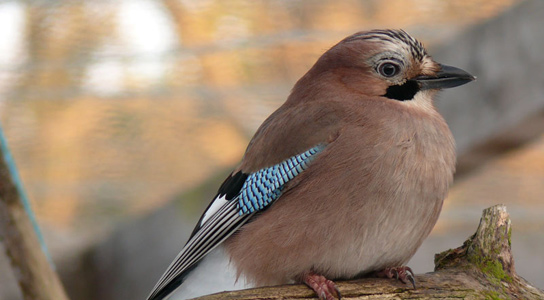
Eurasian jays pay attention to the sounds they and other jays make. Credit: Kylie Millar
A new study indicates that Eurasian jays (Garrulus glandarius) are aware that others may be watching them while they hide away nuts and seeds for the winter, but they might also be aware when others are surreptitiously listening.
The scientists published their findings in the journal Proceedings of the Royal Society B. In response, the birds change their behaviors, like stashing nuts in quieter places. The findings indicate that the jays may be able to understand another’s point of view, which is an ability that is rarely seen in animals.
Corvids cache food to eat at a later date. They also spy on each other and steal from others’ caches. Researchers think that this behavior led the birds in the family Corvidae to an evolutionary race, with birds evolving various strategies to outwit their rivals, like hiding nuts in the shade, behind barriers, or moving their cache to a new location.
G. glandarius are often robbed by Jackdaws and crows, as well as their own mates. They can also vocally mimic the calls of raptors and songbirds in the wild, as well as the voices of the researchers in the lab. This has led scientists to believe that auditory information is a big part of their cognitive repertoire.
Researchers tested whether the scratching and rustling sounds that G. glandarius made while hiding its nuts might draw the attention of other birds. Previous experiments have shown that North American Western scrub jays would avoid hiding nuts in noisy gravel if a rival was nearby.
Eight birds were tested by providing them with 30 peanuts and two trays for caching. One tray contained soft sand, which was quiet, and the other held gravel, a noisier substrate. In some tests, the jay worked while a competitor watched and listened. In other tests, the jay’s rival was within earshot, but they couldn’t see them.
G. glandarius preferred quiet sand to stash nuts, especially when another bird could hear them. They also preferred it when they were alone. Four birds that used the gravel when a rival was watching and listening changed their behavior when the competitor could only eavesdrop but not see them. The jay’s overall preference for hiding nuts in the sand suggests that these birds, known for their secretive ways, may generally avoid drawing attention to themselves.
The scientists then tested the birds looking to steal caches. The birds fell completely silent when given the opportunity to watch another jay hide its food. This shows the ability to strategize, since they are aware that another bird is listening. In order to be successful, the birds needed to be quiet.
This flexibility in reactions in different social situations, as well as the use of these tactics across different sensory domains, supports the notions that jays have an understanding of others’ points of view, states Lisa Leaver, a behavioral ecologist at the University of Exeter in the UK, who wasn’t involved in the study.
Reference: “Careful cachers and prying pilferers: Eurasian jays (Garrulus glandarius) limit auditory information available to competitors” by Rachael C. Shaw and Nicola S. Clayton, 7 February 2013, Proceedings of the Royal Society B.
DOI: 10.1098/rspb.2012.2238









Eurasian Jays are definitely aware of others’ point of view. My local Jay recognises me as I feed different animals in the park. He has noticed I like to spot him and observe him and has reacted to this by playing hide and seek with me. He shows curiousity when I spot him and doesn’t become frightened. Sometimes he spots me first and lets me know about it. Once I struggled to spot him in the bush where he led me, and he let out a caw to help me locate him.